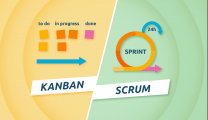Manage Realistic Expectations
Usually, business and client requests are constantly coming in. Effective demand management means that you’re in a position where it’s imperative to say ‘yes, but later’; respectfully but firmly. If your process is brimming with tasks, you ought to ask yourself whether your team is capable of handling new work at that point. That way, you are setting up realistic expectations on what your team can and can’t handle. Start negotiating and making some tough decisions – this is essential if you’re looking to reduce demand, and it usually necessitates focusing on the few valuable work items rather than catering to everyone’s demands.
Making the well-being of your team your top priority and managing realistic goals are crucial components of a successful approach to management. It protects teams from burnout, workflows from getting stuck, and tasks from unnecessary delays.
Postponing a business or customer request can be challenging, but it is also a step towards more efficient work prioritization. Being part of a fast-paced and rapidly evolving market means companies need to be able to identify the work contributing the highest value to their business.
Your capability is limited and demand will always outstrip it. So how do we know whether we have the capacity to deliver on our promises? It’s all about balance. You need to shape the demand so it matches your capacity.
It is far easier (and far more valuable long-term) to be flexible with your demand than it is to try and push the limits of your capacity. The trick here is to only commit to the options that bring value to your business and your customers. In order to achieve that goal, the first thing you need to specify is your commitment point.

Define Your Commitment Point
We usually tend to make more commitments than we can handle. We’re often emotionally attached to the idea of saying ‘yes’, especially to our customers. However, to prevent any dangers of overpromising and under-delivering, it is very important to manage demand effectively and clearly define our commitment point.
Your team commits to delivering a piece of work at the moment they pull it into the workflow . This is your commitment point.
Commitment is not just a promise, it is an engagement. It is a responsibility to deliver the work successfully that your team has taken on.
On the other side, commitments are not contracts either. There is always a chance that they won’t be met so your team should not be blamed if they don’t manage to keep their commitments every time.
Think about failures as opportunities for improvement. Every missed deadline is a chance to improve the way you manage your work and increase your performance.
Your commitment point is the border between your delivery workflow (downstream) and your backlog (upstream).
If we imagine the value stream funnel, the upstream process is above the commitment point. Having a commitment point in place provides a great level of flexibility, as it allows you to reprioritize your items up until the moment they are pulled into the system.
The downstream process is underneath the commitment point. It is the delivery bottleneck in the system. Your capacity is limited. In order to align demand and capability, you have to manage demand effectively to make sure your team only takes on as much work as they are able to handle at a time.
So you should always be mindful of what and how much work is crossing the commitment point. Your goal should always be to bring the most valuable work items to the downstream process.

Consider Your Demand as Optional
Before the commitment point, we work to generate ideas on how we can solve our customer’s problems.
The best piece of advice that we can give you is to always consider your demand as optional. And you must always think about your options objectively. This strategy for approaching demand management is a crucial part of setting realistic expectations.
For example, you may have a nice idea or sometimes even a brilliant idea. That doesn’t necessarily mean this idea will bring value to your business and your customers. You need to validate your idea and assess its feasibility in terms of the risks you’re trying to manage. That’s what aligning options to your business strategy means.
You should never commit to your customer’s requests early. Something that sounded like a good idea once might not make sense later on, particularly as it gets closer to the commitment point.
Committing to our ideas prematurely is a common cause of imbalances between demand and capability.
As you shift your options closer towards your commitment point, they go through the steps of being proven, validated, and confirming that they have a good business case. What’s more, they’re likely to be delivered in a predictable time and to a high quality.












Replies to This Discussion